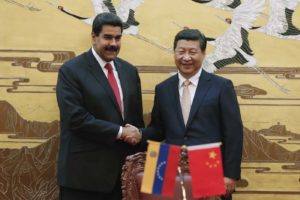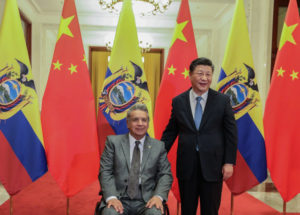Half a million new vehicles – including a significant number of Chinese models – were sold in Venezuela in 2007, an impressive number for the automotive sector given the country’s 28 million population at the time.
Venezuela’s automotive sector was supposed to showcase the potential of Chinese-Venezuelan friendship and industrial cooperation. Yet a decade later, you see scarcely any Chinese cars on the streets. So what happened?
China-Venezuela automotive dreams
In 2004, Venezuela already had one vehicle for every 10.4 inhabitants, a figure almost equal to Brazil (9.9) and much higher than nearby Colombia (17.8) and Ecuador (23.9), according to data from the Venezuela’s Automotive Chamber (Cavenez).
A programme of state subsidies and available credit, driven by public policies promoting the purchase of certain cheaper models, stimulated such demand that newly purchased cars actually appreciated. Reselling in order to purchase even newer models became commonplace. Some 66% of the vehicles sold in 2007 were imported, enabled by a State-run programme of dollar subsidies.
The national vehicle fleet exceeded 5.2 million in 2008, an increase of 113% in 10 years, according to Lílido Ramírez, a researcher at the University of the Andes. This took the ratio to one vehicle for every 5.4 inhabitants. A study by Ramírez praised the work of then-President Hugo Chávez for millions of new car owners and said it played a part Chávez’s successful re-election in 2012, which he won shortly after announcing he had cancer.
Then oil prices fell. Venezuela could no longer afford to subsidise car purchases and allowed imported parts to be assembled locally. But the industry was already shrinking. When crude prices fell further, Venezuela’s automotive industry began to disappear. In 2014, it produced a mere 8,508 vehicles.
Many of Venezuela’s automotive plants are currently paralysed by labour disputes arising from the US$3 billion debt accumulated between 2012 and 2014 from subsidising currencies.
Soon after buying it, it began to have many faults, even though its parts are Nissan. Those cars are useless
The drop in revenue was such that Cavenez was unable to even finance its website. Since 2017, the Venezuelan Chamber of Automotive Products (Favenpa) has provided statistics on car sales. They too threw in the digital towel in July 2018, after experiencing a fall-off in sales of car parts and replacements.
Now, production of some 43% of the 4 million-strong fleet is at a standstill. The latest available data, which comes from a press release, states that between January and September 2019, just 321 cars have been assembled.
Bureaucratic barriers and traps
During the days of plenty, dozens of Chinese brands appeared in Venezuela, in an attempt to control a piece of the growing market. Models from Jonway, Haima, Gac, Gonow, Changan, Hawtai, Geely, JMC, BAW, Chana and Hafei – all Chinese – began to appear at the then popular car shows.
Fifteen years later, only a few models of Geely, Chery and Chana are seen on the streets. Other brands don’t have showrooms in the country.
Oriana Urdaneta from Caracas bought a Zoyte truck that had defects. “It’s a disposable car,” she told Diálogo Chino. “The whole body is familiar but I had to revamp an engine that had done 180,000 kilometres, even though it was Mitsubishi. We bought parts from the brand, but the car is very badly damaged.”
Dentist Mario Gualano from Maracay had a similar experience after purchasing a ZNA. “Soon after buying it, it began to have many faults, even though its parts are Nissan. Those cars are useless,” he said.
Private dealerships sought to capitalise during the boom and some that had no commercial arrangement with China took advantage of the situation.
An example of this was the outrageous case of the La Venezolana dealership, which in 2013 was condemned for defrauding 6,000 people promised Zotye, Brilliance and Kawei brands. The scant 98 cars that arrived in the country ended up in the hands of public institutions, while customers have yet to receive compensation from the dealership despite the fact that they won an August 2019 ruling from the Supreme Court of Justice.
To try to stem the dizzying drop in vehicle production, former President Hugo Chavez invoked his alliance with China and signed agreements to install Chery and Dongfeng assembly plants, as well as the Venirauto scheme, a joint venture with Iran.
1974
the year China and Venezuela established diplomatic relations
Although relations with China date back to 1974, under Chávez they experienced an unprecedented military, political and technical rapprochement. This involved the purchase of radars, planes and three satellites from China, through successive loans that by 2016 were estimated at US$45 billion dollars, channelled through the so-called China-Venezuela Fund.
And although the amounts, conditions and agreements established between China and Venezuela are opaque, Beijing has been reluctant to extend new lines of credit and has asked Caracas for an increase in oil exports. Venezuela is already China’s fourth largest supplier.
In 2010, Chávez toured the Venirauto plant, just months before meeting in Caracas for the ninth time with then Iranian President Mahmud Ahmadineyad, demonstrating the geopolitical importance both countries ascribe to the automotive industry.
Arrival of Chinese cars
First Announced at AutoExpo 2005 in Caracas, privately-owned Chinese manufacturer Great Wall Motors finally acquired a disused plant in Valencia, in the state of Carabobo, in 2009 for US$70 million to assemble vans and economy models jointly with Renault.
After importing some 1,000 cars, a lack of support from the government of Venezuela led the company to shift its focus from the automotive industry to forklift assembly.
This led to the Chavista government’s decision to forcibly occupy the plant in 2013. Two days after the expropriation of Great Wall came the establishment of “Chery de Venezuela”, an alliance between the state-owned manufacturer Chery and ZGT Corporation, owned by Venezuela’s Yammine family, under whose name the brand was already being assembled in a small plant in Las Tejerías, in the coastal state of Aragua.
The move was beneficial to the Yammines, who tried to buy the plant for US$16 million after a six-month rental.
Following the Panama Papers scandal, an report by investigative outlet ArmandoInfo revealed the existence of a network of off-shore companies that imported Chery parts as a means of accessing foreign currencies at subsidised rates.
Even so, in Venezuela, Chery is still portrayed as a public company. In March 2019, it was announced that it had 1,200 vehicles ready to be sold to Venezuelan families, state television claimed at the launch of new “Motor Automotriz”, an initiative aimed at reviving the sector.
Before the end of the year, Chery sold 20 vehicles to the Aragua Police, despite their failure to comply with the safety measures established by the General Police Council (CGP).
Dongfeng’s appropriation
In 2008, the Venezuelan Industrial Consortium of Chinese Technology (Civetchi) was formed by the private Fasiroli Group to import, assemble and sell Chinese state-owned brand Dongfeng vehicles within Venezuela, and to Ecuador and Colombia.
It was a family business with a long history and ranks among the top four largest automotive companies in China. Its owner had convinced Chávez to manufacture “the first Venezuelan truck”. Similar to Great Wall, operations began slowly, so they partnered with the state in 2012. Three years later, the plant in Valencia was the focus of an official joint commission tasked with investigating allegations of embezzlement and fraudulent handling of foreign exchange.
The government didn’t take it lightly. It gave José David Cabello, then Minister of Industry and brother of Diosdado Cabello, the number two in the ruling party, the power to appoint a primary auditing board. The private sector had lost control of the company.
In February 2017, the company was finally taken over by an expropriation decree. Three weeks previously, José Ramón Hernández, a lawyer from Carabobo, who until then had served as Chairman of a second auditing board, had been arrested.
Ironically, in December 2016 the Ministry of Communication had published a report praising Hernández’ work. He conceded that the Fasiroli Group had succeeded in buying a large number of parts for assembly purposes thanks to the profits made from the sale of vehicles in other countries.
According to the report, 40% of production would be allocated to public institutions and 60% to the state programme of controlled sale, known as Venezuela Productiva.
Days before the expropriation, the website KonZapata found that Hernández had made several critical statements in an interview with the state television channel regarding the lack of payments to Venezuela Productiva. It proved to be his downfall. Hernández was prosecuted for selling 89 vehicles without providing spare tyres or paying the luxury tax in August 2016, a month before his appointment. It followed allegations by workers in October 2015 that vehicles were leaving the plant off the books.
236
the number of cars produced by Civetchi in 2016
According to a January 2017 document entitled “Executive Report on the Presidency of Civetchi’s Temporary Management Board” obtained by Diálogo Chino and recently published for the first time, in 2016 only 236 vehicles were produced, less than the 791 in 2015 and far less than the 4,663 in 2014, when the plant was privately run. It also reveals a budget of US$400 million to buy parts to assemble 11,600 Dongfeng vans and Higer buses, at a cost of $24,000 for a van and over $100,000 for the bus chassis.
In November 2016, the union reported that the plant had been in a state of paralysis all year. Responsibility rested with Major Eduan Rodríguez, president of the new board of directors, who had been appointed following Hernández’s arrest and nominated by Lieutenant Colonel Antonio José Pérez Suárez, President of the Socialist Corporation of the Automotive Sector, Venezuela Productiva, Venirauto and Yutong Buses.
Popularly known in Venezuela as “the red buses”, Yutongs had been imported since 2012 for the implementation of rapid bus transit routes until an assembly plant was inaugurated in December 2015 in the state of Yaracuy. It promised to produce 3,600 vehicles per year but only 1,600 have been assembled.
Presented as a joint venture with the Venezuelan State, Yutongs are also synonymous with the “graveyards” of buses that have become unusable owing to the lack of spare parts and specialised service providers. In total, half of the 7,016 imported buses are inactive.
For this reason, at the beginning of 2018 Maduro announced a plan to repair 2,000 buses, and in July 2019 he approved the assembly of another 2,000 buses using the chassis stored at the paralysed Dongfeng plant. A report by the National Assembly concluded that the buses were purchased for US$179,852, an overvaluation of 107%. The figure would have been enough to purchase 10,795 buses.
Corruption behind China-Venezuela industrial cooperation failed to save the Venezuela’s automotive industry, despite promises of technology transfer.
“The widespread disappearance of vehicles due to their high costs and the population’s loss of purchasing power because of hyperinflation, led to a progressive and severe drop in demand,” said Omar Bautista, Favenpa’s president.





![[:en]Local culture and nature are deeply intertwined for a hunter and his eagle near the shore of Lake Issyk Kul. Building on cultural traditions, they are now also engaged in family-based ecotourism operations [image courtesy: Marc Foggin][:]](https://dialogue.earth/content/uploads/2020/07/eagle-and-hunter-300x199.jpeg)


